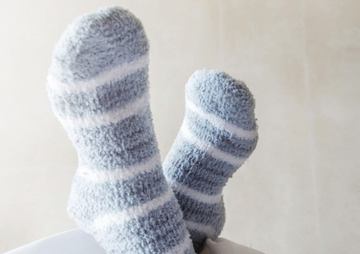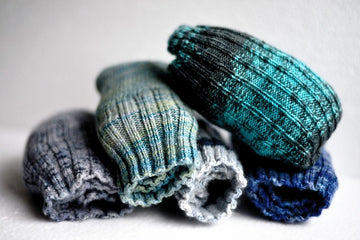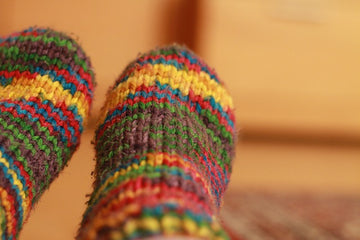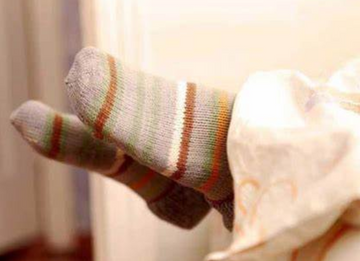
Ever loved a pair of socks only to find they've become a little too loose over time? Don't despair! Shrinking socks is a simple way to breathe new life into your favorite footwear. This guide will explore various methods for shrinking socks, from the classic boiling water trick to the surprisingly effective freezer method. We'll also delve into the science behind sock shrinkage and answer some frequently asked questions.
How to Shrink Socks
Socks that are a little too loose can be a nuisance. But don't toss them out just yet! There are a couple of easy ways to shrink them for a snugger fit.
The Boiling Water Trick
Ever wished your favorite socks clung a little tighter? Don't toss them out just yet! The boiling water method offers a simple solution for shrinking socks to a perfect fit. This technique works wonders on cotton and wool socks.
Let's get started. Bring a pot of water to a rolling boil. Once it's bubbling merrily, gently add your socks. Here's the magic: ten minutes in this hot bath will coax your socks to shrink. The heat forces the fibers to tighten up, creating a snugger embrace for your feet.
But hold on! Don't fish out your socks just yet. To prevent further shrinkage and lock in the new size, immediately rinse them with cold water. Finally, lay them flat to dry.
Voila! You've conquered the boiling water method. So, the next time your socks feel like they're hosting a pool party, this trick is your hero. It's a safe and effective way to achieve that comfy, form-fitting feel you deserve. Say goodbye to sloppy socks and hello to happy feet!
Freeze Your Socks
Feeling like your socks are more like clown shoes than comfy companions? Don't fret! The freezer method is your secret weapon for getting that perfect fit without any heat. Here's the cool (literally) thing about this method: the freezer's icy grip actually shrinks the fibers in your socks, making them hug your feet tighter.
Ready to give it a whirl? First things first, grab a sealable plastic bag and tuck your socks snugly inside. Then, toss those sockcicles into the freezer for a 24-hour snooze. Patience is key here – the longer they chill, the better they shrink!
Once their 24-hour hibernation is over, it's time to thaw them out. Don't be tempted to speed things up – let them come back to room temperature naturally to avoid any wonky fiber situations. Finally, dry them off, and voila! You've got yourself a pair of socks that fit like a dream, no more baggy business!
Oven Magic: Baking Up a Perfect Sock Fit
Conquered the cool approach? Now it's time to heat things up (a bit) with the oven method! This trick is another winner for getting those baggy socks hugging your feet like they should. Plus, it's super easy.
First things first, toss your socks in the washer for a quick cool wash. This preps the fabric for shrinking and gets rid of any extra moisture. Washer done? Skip the dryer! Instead, preheat your oven to a gentle 200°F (think barely warmer than a summer breeze).
Once your oven is toasty, grab a baking sheet and spread your socks out evenly. Think of them as tiny sock pizzas! Bake them for 15 minutes, but keep an eye on them – you don't want any burnt offerings.
When the timer dings, carefully grab those warm socks with oven mitts (safety first!). Let them cool down completely at room temperature before trying them on. This ensures they've finished shrinking and are ready to show off their perfect new fit. Remember, with the oven method, a little supervision goes a long way!
Why Should I Shrink My Socks?
We all love finding socks with amazing designs and colors, but sometimes perfect fit gets sacrificed. That's where the magic of sock shrinking comes in! Shrinking socks is a great way to revitalize a pair that's gotten a bit too loose over time.
But here's the secret: not all socks shrink equally. The key player in sock shrinkage is nylon. Socks with a higher percentage of nylon shrink more effectively when exposed to heat or cold. For instance, a sock made entirely of superwash wool (which has almost no nylon) won't shrink much at all. But a sock with a blend of 75% superwash wool and 25% nylon will shrink noticeably.
So, if you've got a favorite pair of socks that's feeling a little roomy, check the material tag and see if shrinking is an option! It's a simple way to bring those comfy socks back to life.
Can you shrink socks that are too big?
Yes, you can shrink socks that are too big.
- Heat Up the H2O: Bring a pot of water to a boil on the stove.
- Sock Soak: Carefully add your socks and let them simmer for 10 minutes. This hot water bath will shrink the fibers.
- Size Check: After 10 minutes, take the socks out and let them cool completely at room temperature. This will allow you to check the fit. If they're still too big, you can repeat steps 1-3 for another soak. Be cautious though, as too much heat can damage the socks.
Once you're happy with the shrunk size, dry your socks completely. Here's the key: avoid the dryer. High heat can further shrink the socks unevenly or damage them. Instead, lay them flat on a towel or drying rack and let them air dry naturally. This ensures they retain their new size and stay comfy.
Can socks shrink in the dryer?
While dryers are handy for most clothes, they can be a bit rough on your socks. The high heat can cause shrinkage, especially for delicate wool socks. This not only shrinks the size but can also damage the fabric, making them less comfortable and shortening their lifespan.
What causes socks to shrink?
Socks shrink because of a battle between heat and fibers. When you wash socks in hot water or dry them on high heat, the hot temperatures cause the fibers in the fabric to get agitated. Imagine them getting all tangled and bunched up! This tightening makes the socks shrink down a bit.
The type of fabric also plays a role. Cotton, linen, and wool are more susceptible to this shrinking because their fibers react more to heat. So next time you wash your socks, keep the water temperature cool and skip the high heat drying cycle to avoid any unwanted miniaturization!
What happens if you wear socks that are too small?
Wearing socks that are too small can cause some discomfort and even health issues. While a snug fit might feel nice at first, wearing socks that are too small can lead to several problems.
- Circulation Issues: Tight socks can constrict blood flow, especially in the feet and ankles. This can cause swelling, pain, tingling, and numbness. In severe cases, it can even contribute to varicose veins.
- Skin Irritation: Tight socks can rub against your skin, causing irritation, redness, and blisters.
- Nail Problems: Constricted toes can put pressure on your toenails, increasing the risk of ingrown nails.
- Discomfort: Tight socks can simply be uncomfortable to wear, leading to restlessness and fatigue in your feet.
People with certain health conditions, like diabetes or poor circulation, need to be especially careful about wearing socks that are too tight. These conditions can make them more susceptible to the problems listed above.
It's important to choose socks that fit well. They should be snug enough to stay up but not so tight that they cause discomfort or health problems. If your socks feel too tight, it's best to size up for a more comfortable and healthy fit.
Can you shrink socks in the wash?
You can shrink socks in the wash, but with some caveats.
Heat is the key to shrinking most fabrics, but not all socks are created equal. Cotton and wool socks will shrink the most in hot water. Synthetic materials like nylon or polyester might shrink slightly, but not as dramatically.
While a hot water wash cycle can shrink socks, it might not be as effective as the boiling water method mentioned earlier. Boiling water directly exposes the socks to much higher temperatures, leading to more shrinkage.
Extremely hot water can damage some fabrics, especially delicate ones. It's important to check the care label on your socks before tossing them in a hot wash cycle.
How to Shrink Nylon Socks?
Shrinking nylon socks can be tricky because nylon is a synthetic material that resists shrinking compared to cotton or wool.
- Limited Shrinkage: Unfortunately, drying nylon socks on medium heat in the dryer will likely have minimal impact on their size. Nylon fibers are designed to retain their shape and resist heat-induced shrinkage.
- Alternatives for Nylon Socks: If your nylon socks are slightly too big, consider alternative methods that might work better:
- The Freezer Method: This method works for all types of socks, including nylon. Place your socks in a sealed plastic bag and freeze them for 24 hours. The cold temperatures can cause the fibers to contract slightly, leading to a small reduction in size.
- Tailoring: If your nylon socks are significantly too big and other methods don't achieve the desired result, consider taking them to a tailor. They can professionally adjust the size for a perfect fit.
- Caution with Heat: Avoid using the hottest dryer setting or boiling water, as these can damage or melt nylon permanently.
Final Words
By following the tips and tricks in this guide, you can transform your baggy socks back into perfectly snug companions for your feet. Remember, the key to successful sock shrinkage lies in understanding the material and choosing the appropriate method. With a little effort, you can extend the lifespan of your favorite socks and enjoy a comfortable, well-fitting wear. So, grab those slightly-too-big socks and get ready to give them a new lease on life!
From 2022, almost all the clothing enterprises tried their best to tailoring AI marketing, more or less. AI video is an important direction. TopView AI video generator can generate engaging video from a simple URL link. Try to know more about the tool.
Read More:
Why Do We Wear Socks
Do You Wear Socks with Climbing Shoes
What Color Socks with Brown Shoes
What Socks to Wear with Loafers
What are Grip Socks
What Socks to Wear with Cowboy Boots
Are Wool Socks Good for Summer







